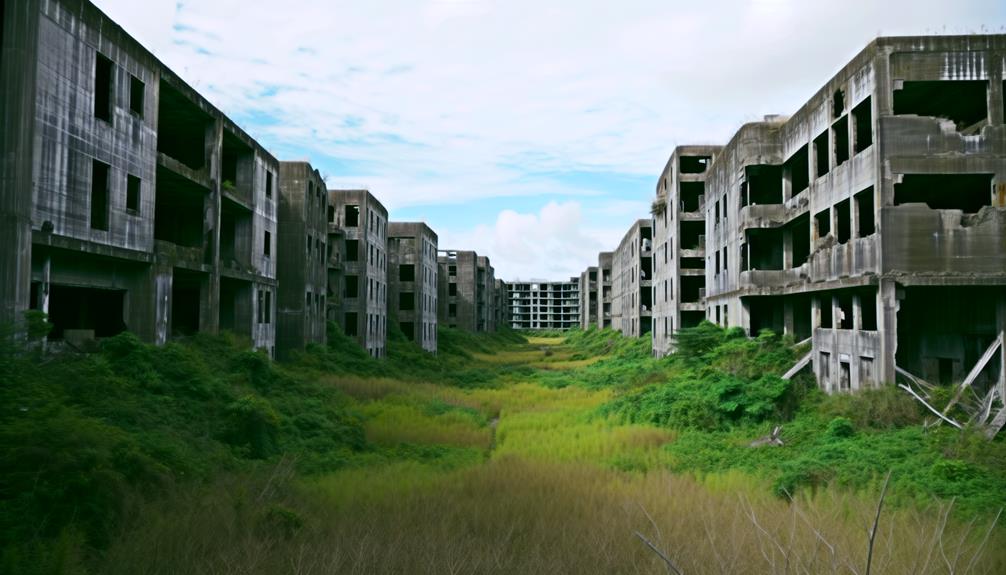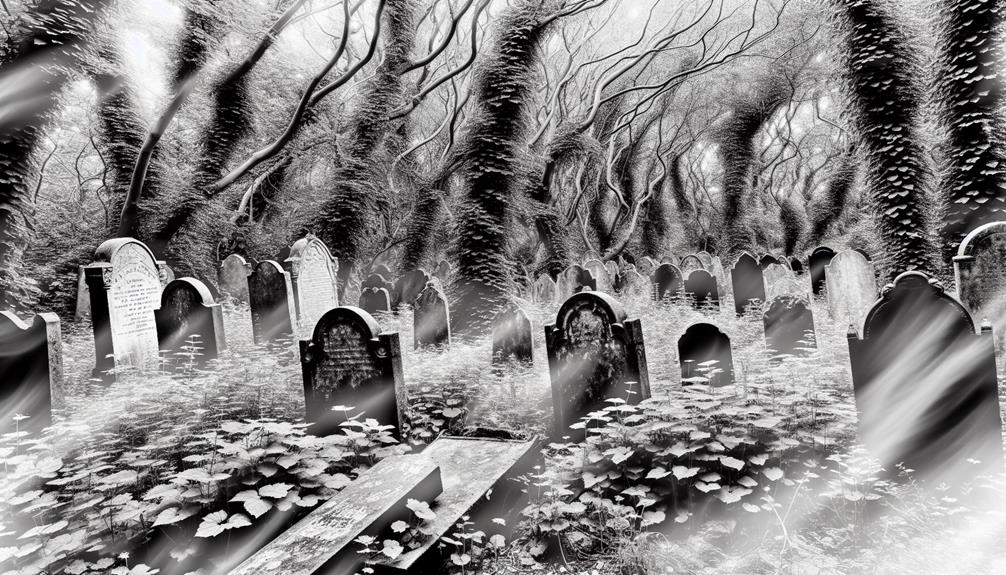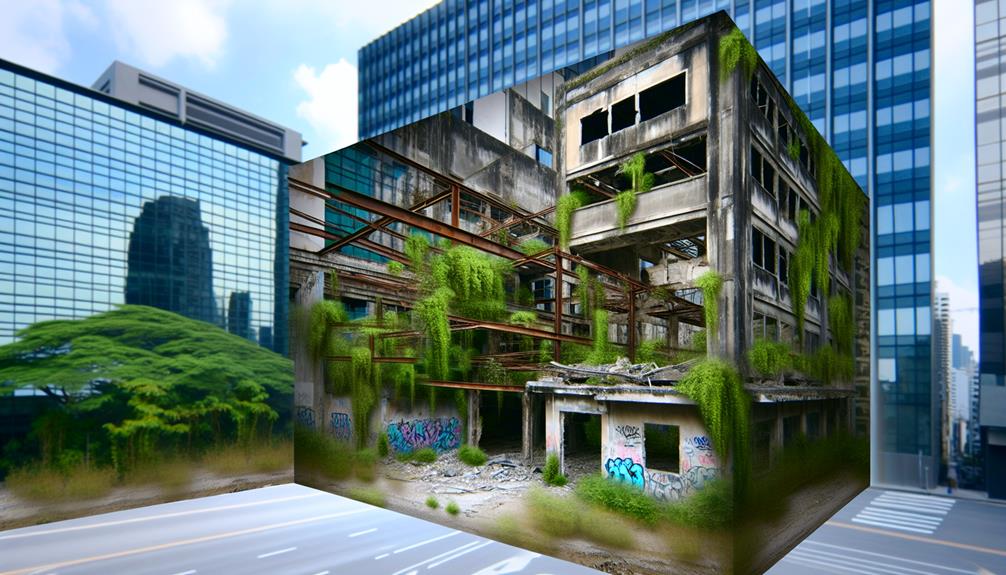Gunkanjima, or Hashima Island, stands as a silent witness to Japan's industrial past, a place where the echoes of prosperity have long faded into the sea breeze. The crumbling concrete structures and rusting remnants on this island tell a story of ambition and decline, offering a stark contrast to Japan's modern landscape. However, beyond its desolate exterior lies a tale of resilience and the human spirit. Exploring the depths of Gunkanjima's history reveals layers of intrigue and mystery waiting to be unraveled, beckoning curious minds to uncover the secrets held within its silent walls.
Key Takeaways
- Gunkanjima is a UNESCO World Heritage site in Japan.
- Opt for guided tours for safe exploration on the island.
- Visit observation decks for panoramic views of the surroundings.
- Capture the haunting beauty of the abandoned island through photography.
- Respect restricted areas for safety reasons during the visit.
History of Gunkanjima
Gunkanjima, also known as Hashima Island, holds a rich historical background, closely intertwined with Japan's industrialization and coal mining industry. During the industrial revolution in Japan, Gunkanjima flourished as an essential site for coal mining, playing a significant role in fueling the nation's rapid modernization and economic growth. The island's strategic location, abundant coal resources, and advanced mining techniques made it a powerhouse in the country's mining sector.
The mining industry on Gunkanjima boomed in the early 20th century, attracting a large workforce seeking employment opportunities. The island's population surged as miners and their families settled in the tightly packed residential areas. The harsh working conditions and demanding hours reflected the sacrifices made by the laborers to propel Japan's industrial revolution forward.
As the coal mining industry expanded, Gunkanjima transformed into a bustling community with schools, hospitals, and recreational facilities to cater to the growing population. The island became a symbol of Japan's industrial prowess, showcasing the nation's ability to harness its natural resources for economic advancement. The legacy of Gunkanjima as a hub of the mining industry continues to resonate, highlighting the enduring impact of Japan's industrial revolution on its development trajectory.
Abandonment and Decline
Experiencing a gradual shift in its fortunes, the once-thriving industrial hub of Gunkanjima witnessed a marked decline and eventual abandonment as the coal mining industry faced challenges and transformations. The island, once a bustling center of activity, saw its population dwindle as coal mines closed down, leading to a mass exodus of residents seeking opportunities elsewhere. The abandoned buildings and structures that once symbolized progress and prosperity now stood as silent witnesses to the island's fall from grace.
The decline of Gunkanjima created a unique opportunity for urban exploration enthusiasts to explore the ruins of a bygone era. The decaying infrastructure and deserted streets became a playground for those intrigued by the haunting beauty of abandonment. Investigating the remnants of a once-thriving community offered a glimpse into the past, allowing visitors to imagine the lives of the people who once called Gunkanjima home.
Urban exploration on Gunkanjima also highlighted the delicate balance between preservation and progress. As nature slowly reclaimed the island, efforts were made to protect its historical significance while also considering opportunities for revitalization. The juxtaposition of decay and potential renewal added a layer of complexity to the narrative of Gunkanjima, inviting further exploration and contemplation of its past, present, and future.
Haunting Beauty of the Island
The abandoned remnants of Gunkanjima stand as a poignant proof to the haunting beauty that emerges from the intersection of decay and history. Eerie allure envelops visitors as they set foot on the island, where architectural ruins tell a story of a once-thriving community now frozen in time. Here are three aspects that contribute to the haunting beauty of Gunkanjima:
- Architectural Ruins: The crumbling concrete buildings, rusted structures, and overgrown vegetation create a surreal landscape that speaks of a bygone era. The stark contrast between the decaying structures and the surrounding sea evokes a sense of melancholy and wonder.
- Eerie Allure: Gunkanjima's desolate atmosphere, with abandoned apartments and silent streets, exudes a mysterious charm that draws in visitors seeking to unravel its secrets. The island's eeriness adds a layer of intrigue to its haunting beauty, inviting contemplation on the passage of time and the impermanence of human creations.
- Historical Significance: Beyond its visual appeal, Gunkanjima holds historical importance as a symbol of Japan's industrialization and subsequent decline. The remnants of coal mining facilities and residential buildings offer a glimpse into the lives of the thousands who once inhabited the island, adding depth to its haunting beauty.
Preservation Efforts and Challenges
Preservation efforts for Gunkanjima face a myriad of challenges stemming from the island's unique blend of historical significance and natural decay. One of the primary challenges faced in preserving Gunkanjima, also known as Hashima Island, is the harsh maritime climate of the Nagasaki region. The constant exposure to saltwater and strong winds accelerates the deterioration of the island's structures, making restoration projects a race against time.
Furthermore, the abandoned island's concrete buildings, once symbols of industrial progress, now stand as haunting reminders of a bygone era. The delicate balance between maintaining the island's historical integrity and ensuring visitor safety poses a significant challenge for restoration efforts.
Another obstacle to preservation is the financial burden associated with stabilizing the structures and implementing necessary safety measures. As Gunkanjima's popularity as a tourist destination grows, finding sustainable funding sources for ongoing maintenance and conservation becomes imperative.
Despite these challenges, various restoration projects have been undertaken to safeguard Gunkanjima's heritage. These initiatives focus on stabilizing the deteriorating buildings, controlling vegetation growth, and implementing measures to protect against further decay. By addressing the challenges faced head-on and engaging in continuous preservation efforts, Gunkanjima can continue to offer a glimpse into Japan's industrial past for future generations.
Visiting Gunkanjima Today
With the growing interest from tourists and history enthusiasts, Gunkanjima stands as a fascinating destination that offers a unique glimpse into Japan's industrial past. The island, also known as Hashima, is a UNESCO World Heritage site located off the coast of Nagasaki. Here are three exploration tips for visitors keen on uncovering the architectural wonders of Gunkanjima:
- Guided Tours: Opting for a guided tour is highly recommended to navigate the island safely. Knowledgeable guides provide valuable insights into the history and significance of Gunkanjima's structures, ensuring a thorough experience.
- Observation Decks: Make sure to visit the observation decks on the island. These vantage points offer panoramic views of the abandoned buildings, sea walls, and unique concrete structures, allowing visitors to appreciate the architectural complexity of Gunkanjima.
- Photography: Gunkanjima is a photographer's paradise. Capture the haunting beauty of the decaying buildings, rusted facilities, and intricate details that showcase the island's industrial past. Remember to respect any restricted areas for safety reasons.
Frequently Asked Questions
What Is the Significance of Gunkanjima's Architecture?
When exploring the significance of architecture in the context of Japanese history and urban decay, one must consider the evolution of design philosophies and societal shifts that have influenced the built environment.
Architecture serves as a reflection of cultural values, economic prosperity, and technological advancements. In regions experiencing urban decay, buildings may stand as poignant reminders of past glory or serve as symbols of neglect and abandonment, offering insights into the complexities of urban development and decline.
Are There Any Hidden Tunnels or Secret Passages on the Island?
Exploration opportunities often reveal historical mysteries, sparking curiosity about hidden tunnels and secret passages. Such enigmatic structures not only offer a sense of adventure but also hold the potential to uncover insights into the past.
Understanding the layout of these concealed pathways can illuminate the historical context of a location, providing a glimpse into the lives of those who navigated through these covert passageways.
Can Visitors Explore the Underwater Ruins Surrounding the Island?
Exploring underwater ruins can offer an exciting and immersive adventure for visitors seeking to uncover hidden remnants of the past.
The allure of delving into submerged historical sites allows enthusiasts to connect with history in a unique and tangible way.
Scuba diving or snorkeling in these underwater locales provides a sense of exploration and discovery, offering a glimpse into a world that was once bustling with activity and now lies beneath the surface waiting to be explored.
How Has the Local Wildlife Adapted to the Harsh Conditions on Gunkanjima?
In challenging environments, wildlife showcases remarkable adaptive strategies to endure harsh conditions. Wildlife behavior and adaptation are intricately linked as species evolve to survive environmental challenges.
Species display a spectrum of responses, from physiological changes to altered behaviors, all aimed at enhancing survival. Understanding these mechanisms provides insights into the resilience and ingenuity of wildlife in facing adversity, highlighting the intricate dance between organisms and their habitats in the quest for survival.
Is There Any Evidence of Paranormal Activity Reported on the Island?
When exploring reports of paranormal activity, it is essential to approach the subject with a critical and open mind. Ghost sightings and mysterious sounds often form the basis of claims regarding supernatural occurrences.
The history of alleged hauntings and inexplicable phenomena can be a fascinating topic for those intrigued by the possibility of unexplained events. Investigating such claims requires a balanced perspective that considers both skepticism and curiosity.
Conclusion
To wrap up, Gunkanjima stands as a ghostly reminder of Japan's industrial past, frozen in time amidst the harsh maritime environment.
Like a faded photograph, the haunting beauty of the abandoned island serves as a testament to the once-thriving community that inhabited its shores.
Despite the challenges of preservation, Gunkanjima's desolate landscape continues to captivate visitors, offering a glimpse into a bygone era of Japan's history.


